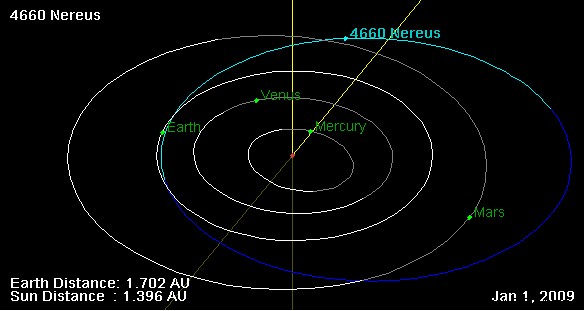In a few days, an asteroid with a diameter roughly similar to the size of the Eiffel Tower will approach Earth. However, the latter will be far, very far from representing any danger. Moreover, the passage of this object will be a good way to observe it and learn more about it.
A few weeks ago, an asteroid "grazed" our planet. Called 2021 TG14, this one passed less than 250,000 km away. Sometimes, however, some can pass much closer . This was the case of 2020 JJ in May 2020, at a distance of only 13,400 km, the discovery of which was very late. However, if its diameter between 2.7 and 6 m is not very impressive, its speed of movement is a little more:51,000 km/h.
According to a Science Alert article from December 2, 2021, Asteroid 4660 Nereus (or Nereus) is approaching Earth and should cross its orbit on December 11. Is this a threat? The object would have a diameter of 330 meters according to NASA's Jet Propulsion Laboratory. Thus, comparison with the famous Eiffel Tower is no coincidence since the latter is 324 meters high.
By the way, Nereus belongs to the category of Apollon near-Earth asteroids that are closely monitored. Recall that the last time an asteroid of this type had crossed the vicinity of Earth was March 22, 2011 at a distance of 66 million kilometers , hence a total absence of danger.

Nereus represents no danger either, and it shouldn't change. Nevertheless, it has been classified as potentially dangerous (Potentially Hazardous Asteroid ) for different reasons. Indeed, first there is its size, over 140 meters in diameter, and the fact that NASA also records any fast-moving object within 7.5 million kilometers or less of our planet. However, the asteroid measures 330 m in diameter and will pass at about four million kilometers of our planet. This distance is rather small on the scale of space and yet it is still more than ten times the Earth-Moon distance.
Furthermore, if Nereus has been talked about for its comparison with the Eiffel Tower and its passage quite close to the Earth, this one has more interesting characteristics. For example, the fact is that this object regularly passes close to our planet , so that this December 11 will be a good opportunity to observe it and get to know it better. Its next passage will be on March 2, 2031, at a distance of seventeen million kilometers.